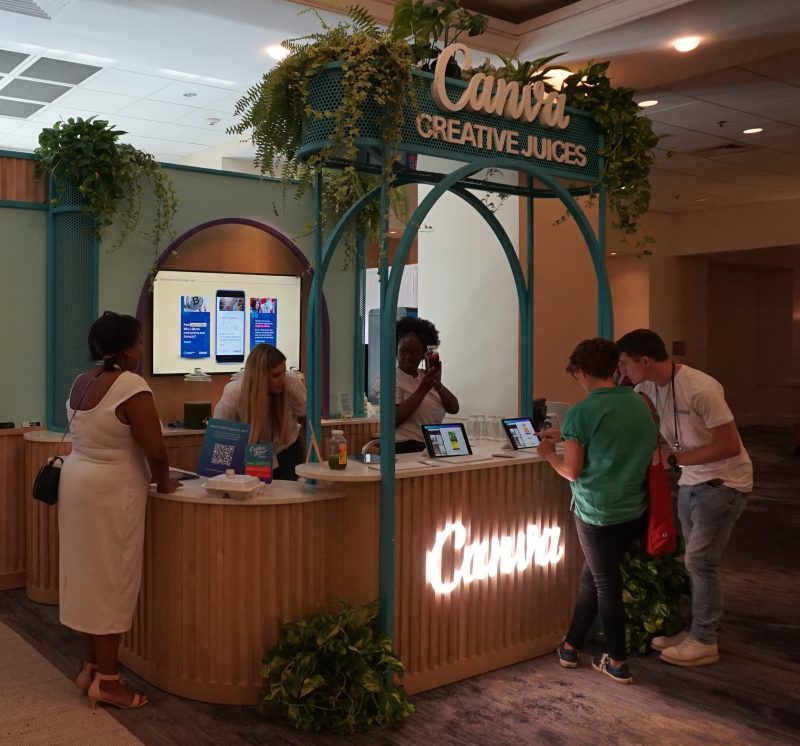Canva and its data visualization platform Flourish are lowering the barrier of entry for newsrooms to meet a growing demand for visual content. As newsrooms harness the potential of the platform, the need for visual literacy education grows.
A sponsor of ONA23, Canva streamlines the creation of graphics, videos, presentations, promotional materials and data visualizations. The company’s goal is to reduce the learning curve traditionally associated with digital design.
“Communication at its core is an integral part of humanity,” said Diana Abeleven, senior manager of global strategic partnerships at Canva. “Even dentists use Canva all the time.”
Despite its versatility across industries, newsrooms are some of Canva’s primary customers. Both platforms provide hundreds of thousands of templates and user-friendly tools to “democratize storytelling,” said María Fernanda Callejón, data visualization specialist at Flourish.
When workflows are built around a platform that targets those who are not visually-oriented or who lack design training, ethical concerns arise for some within newsrooms.
“Ethical visual literacy is something that several editors at this conference see as a need to grow in the space,” said Andrew Stanfill, a photo editor and former president of The National Press Photographers Association (NPPA). “We often talk about how to create new products here, but we don’t then pick up that part of the education of, ‘What does a visual editor do beyond picking the best image or the best illustration?’”
NPPA’s Code of Ethics states that images should not be manipulated to misrepresent subjects and that, “Editing should maintain the integrity of the photographic images’ content and context.” The organization is working to incorporate visual literacy education in future ONA conferences to ensure that journalists can optimize use of powerful digital tools without compromising ethical codes.
“The ethics need to always be part of the conversation,” Stanfill said. “It can’t be siloed.”
As newsrooms restructure and adapt to changing media landscapes, reporters are expected to “wear more hats,” Abeleven said. Although the new wave of journalists funneling out of universities often receive instruction in multimedia skills, many journalists in the newsroom lack formal art and color training to make visuals that supplement or promote their stories, Abeleven said.
Canva goes beyond the newsroom to ease staffing issues. When the creative director of Global Press, a nonprofit that trains women reporters in the world’s least-covered places, stepped down for a medical leave, she designed Canva templates for the team. The organization could then maintain its brand integrity in her absence, said Global Press CEO Cristi Hegranes. Global Press’s Canva team now includes 28 employees, and onboarding new users only takes 45 minutes, Hegranes said.
Using Canva’s streamlined suite of visual tools, even untrained journalists can adapt to new tasks in the newsroom. With the platform, “you’re a chameleon,” said Abeleven.
Canva acquired Flourish in 2022 to expand its visualization capabilities. Like its parent company, Flourish aims to eliminate challenges associated with creating appealing charts, graphs and maps by removing the need for coding. They demonstrate design possibilities with templates like the graph below:
Creating a Flourish visualization begins with the selection of a template from the library, which ranges from bar charts to advanced maps. Before customizing the appearance of the visualization, users upload or copy and paste their own data set. The final product can be embedded in a website’s CMS or into another design on Canva.
Multilingual news organizations can achieve uniformity with Canva’s Translate feature, which simplifies the translation of text down to a few clicks. Designs can be recreated in 134 available languages without the risk of altering other elements.
Canva helps organizations master the breadth of company-wide branding, but it also services individuals developing their own creative brand.
Sofiya Ballin, a self-proclaimed “non-traditional” filmmaker, uses Canva in the planning stages of independent film projects for her series, Black History Untold.
To share her vision, Ballin uses Canva’s motion graphics, tools to adjust imported video and wide gallery of stock video to develop pitch decks that “bring people along for the ride” and help make the storytelling process collaborative.
When used in line with ethical codes for journalists, Canva increases accessibility to the creation of visually appealing, cohesive content to transform workflows.
“For any comm[unications] touch point,” Abeleven said, “Canva can have a role to play internally and externally.”






